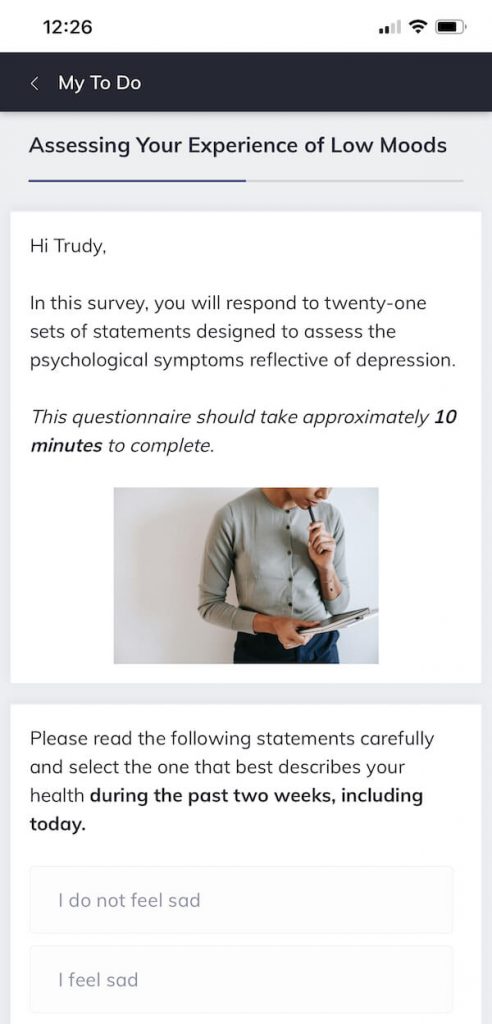
Planning – some of us love it, some of us hate it, and some of us equitable don ’ t have any idea how to do it !
part of effective mental health treatment is the development of a discussion plan .
A good mental health professional will work collaboratively with the node to construct a treatment plan that has accomplishable goals that provide the best chances of treatment success.
Read on to learn more about mental health treatment plans, how they are constructed, and how they can help .
Before you continue, we thought you might like to download our three Positive Psychology Exercises for free. These science-based exercises will explore cardinal aspects of positive psychology including strengths, values, and self-compassion, and will give you the tools to enhance the wellbeing of your clients, students, or employees .
Contents
What is a Treatment Plan? A Definition
At the most basic level, a mental health treatment plan is plainly a typeset of written instructions and records relating to the treatment of an ailment or illness. A treatment design will include the patient or customer ’ s personal data, the diagnosis ( or diagnoses, as is frequently the case with mental illness ), a general outline of the treatment order, and space to measure result as the customer progresses through discussion .
A treatment plan does many things, the most crucial of which include ( Leahy, Holland, & McGinn, 2011 ; PHN, 2017 ) :
- Defining the problem or ailment
- Describing the treatment prescribed by the health/mental health professional
- Setting a timeline for treatment progress (whether it’s a vague timeline or includes specific milestones)
- Identifying the major treatment goals
- Noting important milestones and objectives
This documentation of the most important components of treatment helps the therapist and client stay on the same page, provides an opportunity for discussion of the treatment as planned, and can act as a reminder and motivational cock .
A wide range of people can benefit from mental health treatment plans, including :
- People living with a serious mental illness
- People experiencing distress in one or more areas of life
- Children, parents, and/or families
- The elderly
- Individuals
- Couples
- People with developmental disabilities
- People experiencing sexual or gender identity issues
- People being bullied and/or abused
- Bullies and/or abusers
- People in the criminal justice system
- Employers and/or employees (Croft, 2015).
While people in alike circumstances with exchangeable issues may have alike treatment plans, it ’ south authoritative to understand that each treatment plan is singular .
There are frequently many unlike ways to treat the lapp problem – sometimes there are dozens of different paths that treatment could take !
No two treatment plans will be precisely the like, because no two people ’ randomness experiences are precisely the same .
What, Exactly, is in a Treatment Plan?
 While the basic components of a mental health treatment plan are listed above, there are many more possible additions to a treatment plan.
While the basic components of a mental health treatment plan are listed above, there are many more possible additions to a treatment plan.
While the basic components of a mental health treatment plan are listed above, there are many more possible additions to a discussion plan. As noted earlier, all treatment plans are different – they are unique products of the discussions between a therapist and customer, the therapist ’ s clinical cognition, and the client ’ randomness shared experience .
even in identical diagnoses in like individuals, differences are bound to manifest in any or all of the watch components :
- History and Demographics – client’s psychosocial history, history of the symptoms, any past treatment information
- Assessment/Diagnosis – the therapist or clinician’s diagnosis of the client’s mental health issues, and any past diagnoses will also be noted
- Presenting Concerns – the problems or symptoms that initially brought the client in
- Treatment Contract – the contract between the therapist and client that summarizes the goals of treatment
- Responsibility – a section on who is responsible for which components of treatment (client will be responsible for many, the therapist for others)
- Strengths – the strengths and resources the client brings to treatment (can include family support, character strengths, material support, etc.)
- Treatment Goals – the “building blocks” of the plan, which should be specific, realistic, customized for the client, and measurable
- Objectives – goals are the larger, more broad outcomes the therapist and client are working for, while multiple objectives make up each goal; they are small, achievable steps that make up a goal
- Modality, Frequency, and Targets – different modalities are often applied to different goals, requiring a plan that pairs modalities, a frequency of sessions, anticipated completion date, etc., with the respective goal
- Interventions – the techniques, exercises, interventions, etc., that will be applied in order to work toward each goal
- Progress/Outcomes – a good treatment plan must include space for tracking progress towards objectives and goals (Hansen, 1996)
The therapist and node will work together to get this information down on newspaper, with the therapist contributing his or her expertness in treatments and treatment outcomes, and the customer contributing expertness in his or her own life and experiences .
Why Use a Treatment Plan?
Besides the obvious benefits that planning normally brings, there are a few particular advantages that mental health discussion plans impart to those who use them .
These benefits include :
- Treatment plans provide a guide to treatment for both the therapist and client.
- Treatment plans can reduce the risk of fraud, waste, abuse, and the potential to cause unintentional harm to clients.
- Treatment plans facilitate easy and effective billing since all services rendered are documented.
- Treatment plans can help smooth any potential bumps in treatment, especially if a client requires a kind of treatment the primary therapist cannot provide (e.g., a certain type of intervention or a prescription for medication) or must see a new therapist for some other reason (e.g., if the client or therapist has moved, or the therapist is on extended leave, PHN, 2017).
While treatment plans are quite popular in mental health discussion, it should be noted that not every therapist or clinician will use one. treatment plans are not inevitably required to give or receive successful discussion, but they can be extremely helpful in facilitating a smooth and hassle-free treatment know .
Goals and Objectives of a Treatment Plan
 Goals and objectives will vary tremendously from one person to the next, especially those facing very different problems.
Goals and objectives will vary tremendously from one person to the next, especially those facing very different problems.
Goals and objectives will vary enormously from one person to the adjacent, specially those confront very different problems. If you or your customer is committed to change but isn ’ t quite sure where to begin, this yoke of likely goals can spark a useful discussion about where to go from here .
Goals are the broadest class of accomplishment that clients in mental health counseling work towards. For exemplify, a common goal for those struggling with message abuse may be to quit using their drug of choice or alcohol, while a patient struggling with depression may set a finish to reduce their self-destructive thoughts .
In cosmopolitan, these goals should be realistic – they should be fair, given the client ’ s general experience and hopes for the future .
Objectives are basically goals broken into smaller pieces – many like or subsequent objectives will make up a finish .
For example, an objective for an individual with extreme anxiety may be to take 10 steps outside their front door. The future objective may be to make it to the neighborhood market, or up to 30 steps outside their front door .
Meeting each objective will finally lead you to meet the goal .
How to Create a Treatment Plan
There are many resources out there on how to create a genial health treatment plan – there ’ s even a WikiHow page on the subject !
This checklist is an particularly good resource for treatment plan, due in character to how brief and to-the-point it is. The checklist breaks down treatment plans into five sections : Problem Statements, Goals, Objectives, Interventions, and General Checklist .
The checklist items are presented by section as follows :
Problem Statements
- Do problem statements reflect the six problem domains?
1 – Medical status
2 – Employment and support
3 – Drug/Alcohol use
4 – Legal status
5 – Family/Social status
6 – Psychiatric status - Are problem statements written in behavioral terms?
- Are problem statements written in a non-judgmental and jargon-free manner?
- Are problem statements based on priority needs?
What does the client want to achieve during treatment?
- Do goals address the problem statements?
- Are the goals attainable during the active treatment phase?
- Would the client be able to understand the goals as written?
- Would both the client and the treatment program find these goals acceptable?
- Has the client’s stage of readiness to change been considered in the goal statements?
Objectives
What will the client say or do ? Under what circumstances ? How much will he/she say or do this ?
- Do objectives address the goals?
- Are the goals SMART?
o Specific – Are specific activities included? Could the client understand what is expected?
o Measurable – Can change or progress toward meeting the objectives be documented/evaluated?
o Attainable – Can the client take steps toward meeting the objectives?
o Realistic – Can the client meet the objectives given their current situation?
o Time-Limited/Timely – Is the time frame specified for the objectives? - Has the client’s stage of readiness to change been considered in the objectives?
Interventions
What will the counselor/staff do to assist the customer ? Under what circumstances ?
- Do interventions address the objectives?
- Are the interventions SMART (Locke & Latham, 1990)?
o Specific – Are specific staff persons responsible for assisting client/providing service?
o Measurable – Will the counselor/treatment program be held accountable for the services?
o Attainable – Do interventions reflect the level of care available or are outside referrals used when needed?
o Realistic – Do the interventions reflect the level of functioning or functional impairment of the client?
o Time-Limited/Timely – Is the time frame specified for the interventions? - Has the client’s stage of readiness to change been considered in the interventions (Rollnick, Heather, Gold, & Hall, 1992)?
General Checklist
- Is this treatment plan individualized to fit the client based on their unique abilities, goals, lifestyle, socio-economic status (SES), work history, educational background, and culture?
- Are the client’s strengths incorporated into the treatment plan?
- Has the client (and significant others) participated in developing this treatment plan?
- Is the plan dated and signed by all who participated in developing this treatment plan?
not every treatment plan will call for each of these items. This is fine since every treatment design is arsenic individual as the node treated, but it should be noted why the item does not apply .
When each item is “ checked ” off the list ( or addressed in writing if it is not applicable ), the treatment plan is likely a dependable one – or, at least, it has the basics of a good discussion plan !
If you ’ ra matter to in learning more about creating commodity discussion plans, this easy-to-read, three-page PDF includes some advice on setting good goals for a client-centered treatment plan .
If you work with children and would like some tips on preparing a adept treatment plan for a young client, check out the Pennsylvania CASSP Training and Technical Assistance Institute ’ s publication on this subject here .
Technologies to Support Mental Health Treatment Plans (Incl. Quenza)
 At face value, executing all the components of a mental health discussion design may seem like a draw to address in a series of fifty-minute therapy sessions .
At face value, executing all the components of a mental health discussion design may seem like a draw to address in a series of fifty-minute therapy sessions .
however, therapists are increasingly leveraging the benefits of technology in creative ways to help develop, execute, and evaluate mental health treatment plans using a blended manage set about .
Blended worry involves the planning of psychological services using telecommunication technologies .
Among these technologies are many digital platforms that therapists can use to supplement real-time therapy sessions to help accomplish the steps included in mental health discussion plans .
For case, using a blended manage chopine such as Quenza, a therapist may carry out some of the initial steps in the assessment/diagnosis phase of a discussion plan, such as by inviting the customer to complete a digital diagnostic questionnaire .
alike, the plan may incorporate assorted psychoeducational interventions which can be delivered digitally, such as lead meditations, reflection exercises, or self-paced teach modules .
A therapist may even use these tools following the conclusion of a customer ’ randomness in-person treatment as part of a follow-up, such as to assess whether a customer has remained psychologically well a few months down the line or requires extra support .
These are equitable a few ideas for how you might use a blended manage instrument such as Quenza to help carry out some steps in a genial health discussion plan .
Examples of Mental Health Treatment Plans
 There are several examples of mental health treatment plans to be found online, and several are linked below:
There are several examples of mental health treatment plans to be found online, and several are linked below:
There are several examples of mental health treatment plans to be found on-line, and several are linked below : This sample treatment design is for a young Medicaid recipient role struggling with symptoms of depression and self-destructive thoughts .
This treatment plan is written for the treatment of a man suffering from schizoaffective disorderliness who is experiencing side effects from his medicine .
If you ’ d like to see more, this web site has a long ton of utilitarian example treatment plans and templates .
A Treatment Plan Template
As noted earlier, one template will not cover all of the possibilities for a client ’ s discussion plan, but this template can at least provide a start luff .
Feel unblock to rearrange, remove, and add as necessitate, but make sure to properly cite the reference if you use it for profit or publish it somewhere ( source data is at the penetrate of the template ) .
A Take-Home Message
In this article, we ’ ve discussed the function and general description of a mental health discussion design .
We hope you have a better idea of how treatment plans work, why therapists use them, and how they can help individuals struggling with mental health problems .
Have you ever created a mental health discussion plan ? Have you always had a mental health discussion plan created for you ? Let us know in the comments !
As constantly, thank you for reading !
We hope you enjoy reading this article. Don ’ thyroxine forget to download our three Positive Psychology Exercises for free .
- Croft, H. (2015). What is a mental health treatment plan? Why is it important? GoodTherapy. Retrieved from https://www.healthyplace.com/other-info/mental-illness-overview/what-is-a-mental-health-treatment-plan-why-is-it-important/
- Hansen, M. (1996). Writing effective treatment plans: The Pennsylvania CASSP model. Retrieved from http://www.ccbh.com/pdfs/Providers/healthchoices/articles/TreatmentPlans.pdf
- Leahy, R. L., Holland, S. J., & McGinn, L. K. (2011). Treatment plans and interventions for depression and anxiety disorders. New York, NY: Guilford Press.
- Locke, E. A. & Latham, G. P. (1990). A theory of goal setting and task performance. Upper
Saddle River, NJ: Prentice-Hall. - PHN. (2017). Mental health treatment plans: A guide for health professionals working in general or private practice. Retrieved from https://www.nwmh.org.au/sites/default/files/2017-06/Mental%20Health%20Treatment%20Plans%20North%20Western%20Melbourne%20PHN.pdf
- Rollnick, S., Heather, N., Gold, R., & Hall, W. (1992). Development of a short ‘readiness to change’ questionnaire for use in brief, opportunistic interventions among excessive drinkers. British Journal of Addiction, 87(5), 743-754.